Intel Xeon E Six-Core Review: E-2186G, E-2176G, E-2146G, and E-2136 Tested
by Ian Cutress on November 5, 2018 12:00 PM EST- Posted in
- CPUs
- Intel
- Xeon
- Enterprise CPUs
- Xeon E
CPU Performance: Office Tests
The Office test suite is designed to focus around more industry standard tests that focus on office workflows, system meetings, some synthetics, but we also bundle compiler performance in with this section. For users that have to evaluate hardware in general, these are usually the benchmarks that most consider.
All of our benchmark results can also be found in our benchmark engine, Bench.
PCMark 10: Industry Standard System Profiler
Futuremark, now known as UL, has developed benchmarks that have become industry standards for around two decades. The latest complete system test suite is PCMark 10, upgrading over PCMark 8 with updated tests and more OpenCL invested into use cases such as video streaming.
PCMark splits its scores into about 14 different areas, including application startup, web, spreadsheets, photo editing, rendering, video conferencing, and physics. We post all of these numbers in our benchmark database, Bench, however the key metric for the review is the overall score.
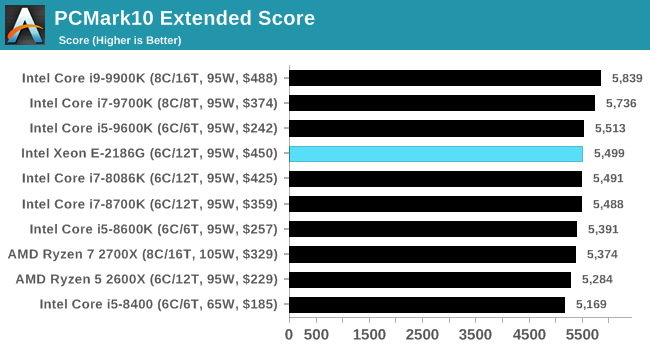
There's a slight issue using PCMark with having IGP drivers installed then restarting the system using a discrete GPU installed. We'll come back and rerun when the time permits.
Chromium Compile: Windows VC++ Compile of Chrome 56
A large number of AnandTech readers are software engineers, looking at how the hardware they use performs. While compiling a Linux kernel is ‘standard’ for the reviewers who often compile, our test is a little more varied – we are using the windows instructions to compile Chrome, specifically a Chrome 56 build from March 2017, as that was when we built the test. Google quite handily gives instructions on how to compile with Windows, along with a 400k file download for the repo.
In our test, using Google’s instructions, we use the MSVC compiler and ninja developer tools to manage the compile. As you may expect, the benchmark is variably threaded, with a mix of DRAM requirements that benefit from faster caches. Data procured in our test is the time taken for the compile, which we convert into compiles per day.
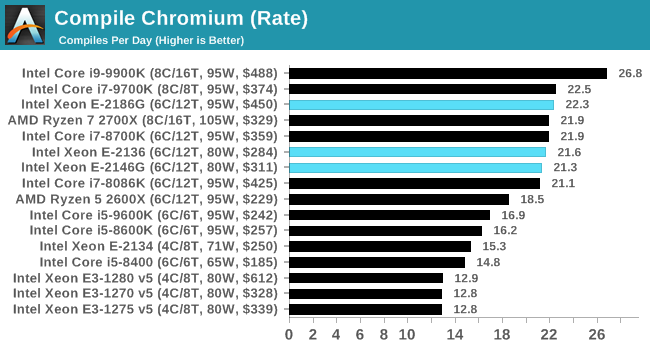
3DMark Physics: In-Game Physics Compute
Alongside PCMark is 3DMark, Futuremark’s (UL’s) gaming test suite. Each gaming tests consists of one or two GPU heavy scenes, along with a physics test that is indicative of when the test was written and the platform it is aimed at. The main overriding tests, in order of complexity, are Ice Storm, Cloud Gate, Sky Diver, Fire Strike, and Time Spy.
Some of the subtests offer variants, such as Ice Storm Unlimited, which is aimed at mobile platforms with an off-screen rendering, or Fire Strike Ultra which is aimed at high-end 4K systems with lots of the added features turned on. Time Spy also currently has an AVX-512 mode (which we may be using in the future).
For our tests, we report in Bench the results from every physics test, but for the sake of the review we keep it to the most demanding of each scene: Ice Storm Unlimited, Cloud Gate, Sky Diver, Fire Strike Ultra, and Time Spy.
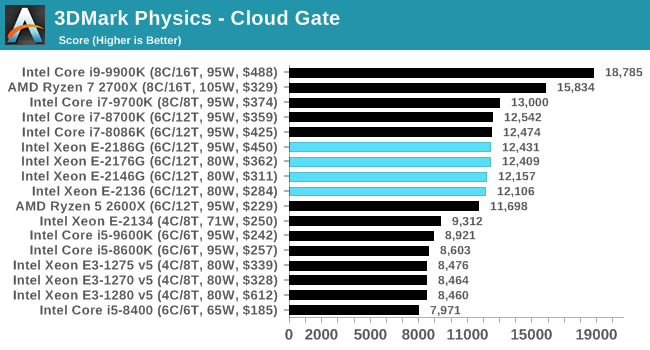
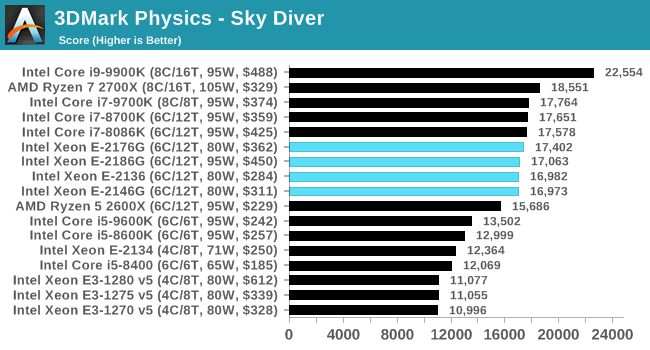
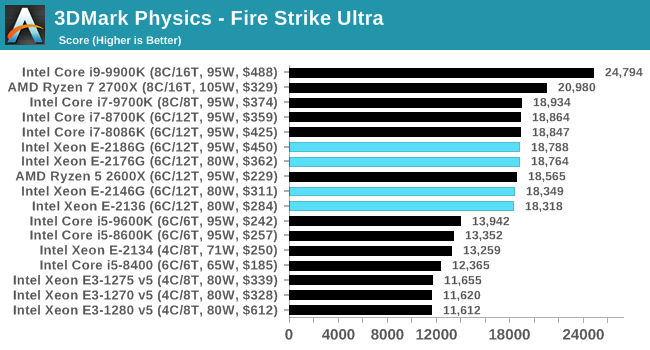
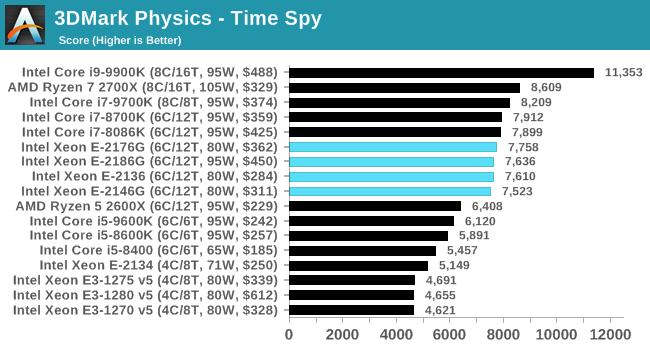
GeekBench4: Synthetics
A common tool for cross-platform testing between mobile, PC, and Mac, GeekBench 4 is an ultimate exercise in synthetic testing across a range of algorithms looking for peak throughput. Tests include encryption, compression, fast Fourier transform, memory operations, n-body physics, matrix operations, histogram manipulation, and HTML parsing.
I’m including this test due to popular demand, although the results do come across as overly synthetic, and a lot of users often put a lot of weight behind the test due to the fact that it is compiled across different platforms (although with different compilers).
We record the main subtest scores (Crypto, Integer, Floating Point, Memory) in our benchmark database, but for the review we post the overall single and multi-threaded results.
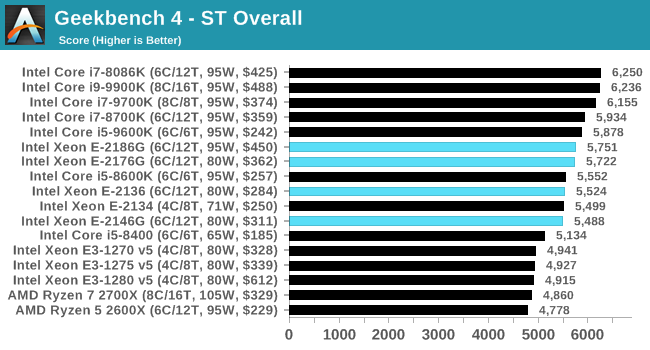
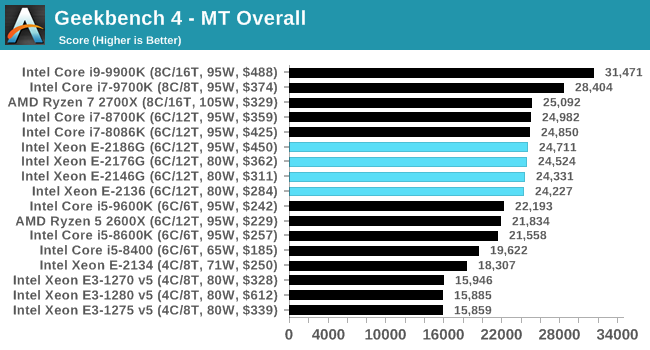










48 Comments
View All Comments
Jorgp2 - Monday, November 5, 2018 - link
Why don't you guys test iGPU encoding performance?speculatrix - Tuesday, November 6, 2018 - link
I agree, it would be useful to see video transcode performance, there's a few times when you want a media server with fast video transcode performance (i.e. real time 1080p60).Samus - Tuesday, November 6, 2018 - link
I'd also like to know where Quicksync performance lies on the new Xeons...mooninite - Wednesday, November 7, 2018 - link
Yes! I'd love to see iGPU encoding numbers, too. I would be buying one of these Xeons to get the encoding offloading you couldn't get with a Threadripper or EPYC.kuttan - Sunday, November 11, 2018 - link
For iGPU encoding you don't need a Xeon. For that any IGP based consumer desktop CPUs like Core i3/i5 or AMD Ryzen 2400G APU will do at a much cheaper price.mooninite - Tuesday, November 13, 2018 - link
@kuttan, you don't understand. I need a *server* system that has IPMI. i3/i5 or Ryzen systems don't provide IPMI. I also need a Micro ATX formfactor with 10GBASE-T NICs. Not going to happen on a i3/i5 or Ryzen system. Thanks though.Vidmo - Wednesday, November 7, 2018 - link
Agreed!shiznit - Wednesday, November 21, 2018 - link
no kidding... top 5 use case for these Xeons.just4U - Monday, November 5, 2018 - link
Thru-out the article I kept thinking.. Oh look a 6core product when 8core processors are becoming the norm at reasonable prices in desktop computers. In server settings I wonder why that would even be something to write home about.Ratman6161 - Monday, November 5, 2018 - link
Well, you really have to want/need that ECC RAM to make this worthwhile. Otherwise there is no point to going with an "E" over the equivalent desktop part.